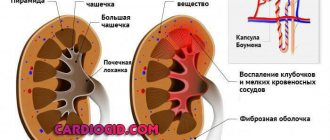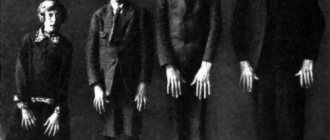Rheumatism (rheumatic fever)
Symptoms of rheumatism are extremely polymorphic and depend on the degree of severity and activity of the process, as well as the involvement of various organs in the process. A typical clinical picture of rheumatism is directly related to a previous streptococcal infection (tonsillitis, scarlet fever, pharyngitis) and develops 1-2 weeks after it. The disease begins acutely with low-grade fever (38-39 °C), weakness, fatigue, headaches, and sweating. One of the early manifestations of rheumatism is arthralgia - pain in medium or large joints (ankle, knee, elbow, shoulder, wrist).
With rheumatism, arthralgia is multiple, symmetrical and volatile (pain disappears in some joints and appears in other joints) in nature. There is swelling, swelling, local redness and increased temperature, and a sharp restriction of movement of the affected joints. The course of rheumatic arthritis is usually benign: after a few days the severity of the symptoms subsides, the joints are not deformed, although moderate pain may persist for a long time.
After 1-3 weeks, rheumatic carditis occurs: pain in the heart, palpitations, interruptions, shortness of breath; asthenic syndrome (malaise, lethargy, fatigue). Heart damage due to rheumatism is observed in 70-85% of patients. With rheumatic carditis, all or individual membranes of the heart become inflamed. More often, simultaneous damage to the endocardium and myocardium occurs (endomyocarditis), sometimes with involvement of the pericardium (pancarditis), and isolated myocardial damage (myocarditis) may develop. In all cases of rheumatism, the myocardium is involved in the pathological process.
With diffuse myocarditis, shortness of breath, palpitations, interruptions and pain in the heart, cough during exercise, and in severe cases - circulatory failure, cardiac asthma or pulmonary edema. The pulse is small and tachyarrhythmic. Myocardial cardiosclerosis is considered a favorable outcome of diffuse myocarditis.
With endocarditis and endomyocarditis, the mitral (left atrioventricular) valve is most often involved in the rheumatic process, less often the aortic and tricuspid (right atrioventricular) valves. The clinical picture of rheumatic pericarditis is similar to pericarditis of other etiologies.
With rheumatism, the central nervous system can be affected; a specific symptom in this case is the so-called rheumatic or minor chorea: hyperkinesis appears - involuntary twitching of muscle groups, emotional and muscle weakness. Less common are skin manifestations of rheumatism: ring-shaped erythema (in 7–10% of patients) and rheumatic nodules. Erythema annulare (rash annulare) is a ring-shaped, pale pink rash on the trunk and legs; rheumatic subcutaneous nodules - dense, round, painless, inactive, single or multiple nodules localized in the area of medium and large joints.
Damage to the kidneys, abdominal cavity, lungs and other organs occurs in severe cases of rheumatism, which is extremely rare at present. Rheumatic lung damage occurs in the form of rheumatic pneumonia or pleurisy (dry or exudative). With rheumatic kidney damage, red blood cells and protein are detected in the urine, and a clinical picture of nephritis occurs. Damage to the abdominal organs during rheumatism is characterized by the development of abdominal syndrome: abdominal pain, vomiting, tension in the abdominal muscles. Repeated rheumatic attacks develop under the influence of hypothermia, infections, physical stress and occur with a predominance of symptoms of heart damage.
Rheumatic diseases
Rheumatic diseases
include a wide range of diseases that primarily affect joints and periarticular tissues. A special group among them consists of systemic diseases - collagenosis and vasculitis, characterized by autoimmune genesis, local or diffuse damage to connective tissue. Rheumatic diseases are studied by a specialized branch of internal medicine - rheumatology. The course of rheumatic diseases is often accompanied by multiple organ damage with the development of cardiac, renal, pulmonary, and cerebral syndromes, the treatment of which involves not only rheumatologists, but also specialized specialists - cardiologists, nephrologists, pulmonologists, neurologists. Rheumatic diseases have a progressive course, disrupt the patient’s functional activity and can lead to disability.
Rheumatic diseases such as gout and arthritis have been known since the time of the ancient Greek healer Hippocrates. In the II century. n. e. The Roman philosopher and surgeon Galen coined the term “rheumatism,” which denoted a variety of diseases of the musculoskeletal system. And only in the XVIII - XIX centuries. Descriptions of individual rheumatic diseases began to appear. Currently, according to the American Society of Rheumatology, there are over 200 types of rheumatic pathology.
Depending on the predominant lesion, the whole variety of rheumatic diseases can be divided into three large groups: joint diseases, systemic vasculitis and diffuse connective tissue diseases. Joint diseases are represented mainly by arthritis (rheumatoid, psoriatic, gouty, reactive, infectious, etc.), as well as osteoarthritis, ankylosing spondylitis, rheumatic diseases of the periarticular soft tissues. The group of systemic vasculitis includes hemorrhagic vasculitis, periarteritis nodosa, Wegener's granulomatosis, Horton's disease, Goodpasture's syndrome, Takayasu's disease, thromboangiitis obliterans. Diffuse connective tissue diseases, or systemic diseases, are represented by systemic lupus erythematosus, scleroderma, dermatomyositis, Sjogren's disease, Sharp's syndrome, etc. Separately in the classification of rheumatic diseases is rheumatism, in which simultaneous rheumatic damage to the joints, connective tissue and blood vessels occurs.
Currently, the etiology of rheumatic diseases is considered from the perspective of a multifactorial concept, according to which their development is explained by the interaction of genetic, environmental and endocrine factors. In this case, the genetic factor acts as a predisposing factor, and environmental and endocrine factors act as producing, triggering factors. The most common provoking factors of rheumatic diseases are infections caused by Epstein-Barr viruses, cytomegaly, herpes simplex, picornaviruses, etc.; intoxication, stress, insolation, hypothermia, injury, vaccination; pregnancy, abortion. The unifying links in the pathogenesis of all rheumatic diseases are disruption of immune homeostasis and the development of a severe immunoinflammatory process in connective tissue, microvasculature and joints.
Rheumatic diseases occur among patients of various age groups, including among children and adolescents (for example, arthritis in children, rheumatism in children, juvenile rheumatoid arthritis, connective tissue dysplasia, etc.). However, the peak incidence occurs in adulthood – 45 years and older. Some rheumatic diseases are more likely to develop in people of a certain gender: for example, systemic diseases, rheumatoid arthritis, polymyalgia rheumatica are more typical for women, but gout, psoriatic arthritis, and ankylosing spondylitis usually affect men.
The clinical manifestations of rheumatic diseases are extremely diverse and changeable, however, certain symptomatic markers can be identified, the presence of which should immediately consult a rheumatologist. The main ones include: prolonged causeless fever, arthralgia, swelling and changes in the configuration of joints, morning stiffness, muscle pain, skin rash, lymphadenitis, a tendency to thrombosis or hemorrhage, multiple damage to internal organs. Systemic diseases are often disguised as diseases of the skin, blood, musculoskeletal system, and oncopathology, which require differentiation first of all.
In recent years, significant progress has been made in the diagnosis and treatment of rheumatic diseases, which is associated with the development of genetics, immunology, biochemistry, microbiology, pharmacology, etc. The basis for making a correct diagnosis is immunological studies, which make it possible to identify antibodies corresponding to a specific nosology. Also, radiography, ultrasound, CT, MRI, scintigraphy, arthroscopy, and biopsy are widely used to diagnose rheumatic diseases.
Unfortunately, today a complete cure for rheumatic diseases is impossible. However, modern medicine in most cases can help alleviate the course of the disease, prolong remission, and avoid disabling outcomes and severe complications. Treatment of rheumatic diseases is a long, sometimes lifelong process and consists of drug therapy, non-drug methods, orthopedic treatment and rehabilitation. The basis of therapy for most rheumatic diseases is basic anti-inflammatory drugs, glucocorticosteroids and biological drugs. A significant role in complex therapy is given to extracorporeal hemocorrection - plasmapheresis, hemosorption, cytapheresis, plasmasorption, etc. Non-drug methods of treating rheumatic diseases, such as physiotherapy, balneotherapy, exercise therapy, acupuncture, kinesiotherapy, can significantly improve the functional status of patients. Orthopedic treatment (orthosis, surgical correction of joint function, endoprosthetics) is indicated mainly in the late period of rheumatic pathology to improve the quality of life of patients.
Prevention of rheumatic diseases is nonspecific. To prevent them, it is important to avoid provoking factors (stress, infections, other stresses on the body), pay sufficient attention to physical activity and taking care of your health, and eliminate bad habits. The rapid development of medical technologies allows us to hope for a speedy resolution of unclear issues regarding the occurrence and course of rheumatic diseases.
On the pages of our medical directory, rheumatic and systemic diseases are separated into a separate section.
Here you can get acquainted with the main rheumatic diseases, the causes of their occurrence, symptoms, advanced diagnostic methods, and modern views on treatment. Further…
Causes of rheumatism
Why do some people get rheumatism, while others under the same conditions do not? People who often suffer from ENT diseases are more likely to get rheumatism. Those at risk are those whose relatives have this disease and those who have the B-cell marker D8/17 in their blood.
So, the risk factors:
- streptococcal infection (angina, scarlet fever, pharyngitis);
- defects of the immune system, the presence of autoimmunity;
- genetic predisposition to the disease.
Diagnosis of rheumatism
When diagnosing the disease, the following methods are used:
- ECG;
- Ultrasound of the heart;
- X-ray examination (helps to see changes in the size and shape of the heart);
- general blood test (can show ESR level, anemia, etc.);
- immunological blood test (appearance of C-reactive protein, presence of streptococcal infection).
1 General blood test
2 Immunological blood test
3 Diagnostics of rheumatism in MedicCity
Prevention of rheumatism
Basic preventive measures:
- timely treatment of streptococcal infections;
- completing the full course of antibiotic therapy, if one was prescribed (you cannot stop taking antibiotics earlier than prescribed by the doctor);
- avoiding hypothermia and contact with people with tonsillitis;
- general measures to strengthen the immune system (balanced diet, physical activity, walks in the fresh air).
What happens if you run it?
After the first attack, it can take from several months to several years. Even in the absence of symptoms, the dangerous consequences of rheumatism develop.
The most harmless of them is erythema, a reddening of the skin in the form of a red circle with clear edges. It occurs in most rheumatic diseases. In a quarter of cases, inflammation of the heart tissue leads to the appearance of defects: the heart becomes larger, murmurs appear when listening, and arrhythmia appears. Damage to the mitral valve can lead to heart failure.
Disruption of the nervous system leads to “minor chorea” - involuntary movements of the limbs, muscles of the face, body, impaired coordination, handwriting, and speech defects.
Do not start the disease, consult a doctor (pediatrician or therapist) when the first symptoms appear - both streptococcal infection and signs of rheumatism. To prevent illness, follow the prevention tips.
Clinical picture of rheumatism
The trigger for the development of rheumatism is the entry of streptococcus into the body, as a result of which the immune system begins to produce antibodies to fight the infection. However, in the body itself, namely in connective tissues and heart muscle, there are molecules of the same structure. Due to the presence of this factor, the immune system begins to “fight” its cells. As a result, connective tissue is damaged, and this is fraught with heart defects and joint deformation.
Forms of rheumatism
- cardiac form (cardiac rheumatism), when all the membranes of the heart are affected (pancarditis), myocardium (myocarditis), endocardium (endocarditis);
- articular form (rheumatism of the joints);
- cutaneous form;
- pulmonary form (pleurisy);
- rheumatic chorea (St. Vitus' dance).
General information about rheumatism
Acute rheumatic fever
ー systemic inflammatory disease characterized by damage to joint tissues, heart and blood vessels. Develops in predisposed individuals after suffering a streptococcal infection (pharyngitis, tonsillitis, scarlet fever, erysipelas). Most often it develops in adolescents and young people due to the high reactivity of their immune system.
With this disease, foci of inflammation appear with tissue destruction in large and medium-sized joints, heart tissue, kidneys, and liver. The greatest danger is rheumatic heart disease. This is the most common cause of the formation of acquired heart defects and carries a risk of developing heart failure, thromboembolism (blockage with blood clots) of the pulmonary and cerebral arteries.









